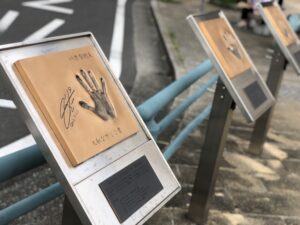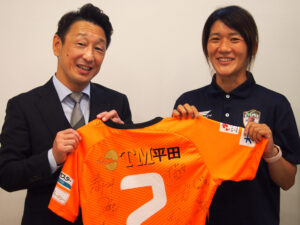A Visit to Nadeshiko’s Hometown Around Japan Episode 9. Yamato Sylphid
Yamato City, at the center of Kanagawa Prefecture, is a bed town accessible an hour or less by train from Shinjuku, Shibuya, and Yokohama. With the slogan, “a city of women’s soccer,” the local government placed the Sports Division of the Culture and Sports Department in Yamato Sports Center instead of City Hall. The Center includes this sports section, where ex-national team member Shiho Onodera works, but also Yamato Nadeshiko Stadium, the home grounds of Yamato Sylphid. The open space in front of Yamato Station, named “Nadeshiko Hiroba”, and its nearby promenade, “Nadeshiko-no-Michi,” are popular among citizens. Walking through the promenade to Yamato Nadeshiko Stadium always reminds soccer fans of how deeply the city is connected to women’s soccer. What was behind the city’s slogan? This time, we visited Yamato City to find out how the team and the people have built close ties to each other.

Street view around Yamato Station
The founding of Yamato Sylphid has changed the city’s sports culture
Morihiro Kawasumi
Before delving into the team’s history, two players, who have since left, should be acknowledged: Nahomi Kawasumi (NJ/NY Gotham FC), and Megumi Kamionobe (Niigata L). Both being first-year members of the team, they played for the 2011 FIFA Women’s World Cup in Germany.
Let’s rewind the clock back to the end of 1980’s. The two were playing on a team of elementary kids. However, the girls and their teammates realized that they would have nowhere to play once they entered junior high school. Unable to find any female soccer team in nearby schools, parents decided to create one for their daughters. After consultations and arrangements, they established the Yamato Sylphid for young-teen girls in 1998. We met one of the parents, Morihiro Kawasumi, the father of Nahomi Kawasumi.

Morihiro Kawasumi (without mask only during the photo session)
Kawasumi said, “First, I was the chair of the arrangement group. Later, when parents set up a youth support organization, I became the chairman and continued for six years.” “The team’s goals and principles are set by the chief director, and training is done by the manager and coaches. Our organization contributes financial help, but never puts our nose into the team’s affairs. The three parties have kept their distance from each other,” he added.
Starting from scratch, the team now struggles to win in the 2021 Plenus Nadeshiko League Division 1.
Kawasumi called the team “the pride of the city,” as it has improved the environment for local girls to play soccer.
“The team’s first manager, Koji Sato, was a junior high teacher, so he was much more than just a soccer coach to the members. He gave guidance on life, such as studying or etiquette, and convinced many students to continue playing soccer after graduation,” he said. “Some members entered Yamato High School to join its soccer club for boys. That led the school to start another club for girls.”

Handprint monument of Nahomi Kawasumi
In 2013, Yamato city government jointly held two ceremonies to honor the achievements of female soccer players deeply connected to the city. One was for the naming of “Yamato Nadeshiko Hiroba,” and the other was for unveiling the handprint monument of players. Kawasumi joined the ceremonies as a guest, which were attended by as many as 2,000 people. The monuments currently displayed are of Nahomi Kawasumi, Megumi Kamionobe, Shinobu Ono (now the Omiya Ardija Ventos coach), and Shiho Onodera.
“I was pleased to see so many people coming to enjoy the event,” said Kawasumi.
The team founded by him and others has been navigating the city towards ‘a city of women’s soccer.’ His daughter, Nahomi Kawasumi helps with the city’s event “Yamato Nadeshiko Soccer Festival.” The spirit of pioneers has been passed down to Yamato Sylphid today.
Once playing with Kawasumi and Kamionobe, mom has a daughter on the current team
Ayako Yamanaka
Ayako Yamanaka, now a mother of two children, was on the team when she was in junior high school. Her daughter now plays in the team’s youth academy. Yamanaka started her soccer career when she was in elementary school ‘because Nahomi Kawasumi, one year older than herself, and her cousin were friends.’

Ayako Yamanaka (without mask during the photo session)
When asked why she continued to play until junior high, Yamanaka answered, “the team was a mixture of different grades, so I enjoyed communicating with the older girls.” “Actually, I was not so keen on soccer itself. Playing with my teammates was fun, even when I had a bad day at school, because they knew nothing about it.” When meeting with her teammates now, who still call her Ayako, she feels like a schoolgirl again.
What is her impression about how Nahomi Kawasumi and Megumi Kamionobe were as early teenage players? “Naho was like a ‘non-aggressive’ leader. The team captain should have been someone else, but she looked like a captain. Megu was the opposite. She was modest and very kind. When I talked to her, she always nodded with a smile, which was quite pleasant.”

The first-year members of Yamato Sylphid, including Megumi Kamionobe and Nahomi Kawasumi (front row, second and third from right)
Photo courtesy: Yamato Sylphid
Yamanaka’s daughter joined the team’s academy after her grandpa, Yamanaka’s father, set the stage for it.
“When my daughter was in first grade elementary school, my dad suddenly came to say, ‘Ayako, I made her join the team,’” she laughed. “He said, ‘I’ll pay for the club fee,’ so I just thanked him and let it go.”
Yamanaka herself has no idea about how she started soccer, not knowing if she even said she wanted to. Her father, an enthusiastic soccer fan, may have guided her to start before she herself knew.
She expressed her feelings for the team as ‘nothing but gratitude.’ “It’s hard to keep playing for the club, you know, but I’m really thankful to them,” she said.
The team still has a member who played with her, Yoshie Hori. In a few years’ time, Hori may chase the ball along with her daughter.
Yamanaka sent a message to her ex-teammate, laughing, “Yocchan (nickname for Hori), I hope you hold on and play a little longer!”
Dreaming of a second Nahomi Kawasumi emerging from the city
Toshihiro Hirata, President, Hiratasousai (TM Inc.)
Hiratasousai, a funeral company, is one of the top partners of Yamato Sylphid.
The president, Toshihiro Hirata, first contacted the club after noticing sponsorship opportunities given the team’s promotion to the Challenge League. Hirata recalled, “I met Morihiro Kawasumi after the company became a top partner. He expressed his gratitude for our support, with a soft voice and gentle manner.”

Toshihiro Hirata, president of Hiratasousai (left) and Rei Takemura, U-15 head coach, also working as club’s PR officer (without masks during the photo session)
“If you buy a TV or a house, you can make your family happy. But you don’t pay for a funeral for happiness, right? So, I wanted to use the money we receive for something useful,” Hirata said.
After seeing the players, muddy and kicking the ball, he decided to apply for top partnership.
Hirata finds great meaning in the local team, as his business provides city-wide services.
“Yamato City doesn’t have any special features or famous tourist spots, or even a professional sports team. But we have players like Kawasumi or Kamionobe, still active in the sport, and Onodera, who joined the Olympic games,” he said. “They are treasures of our city. I hope the team will grow with the help of such famous players. And, I’m so grateful that a small company like us was chosen to be a top partner.” Hirata confessed that he was hoping for “Kawasumi to come back to the team someday.”
Intimacy between players and fans is often said to be a characteristic of women’s soccer. Although Hirata values such a relationship, he rather insists athletes should be admired and regarded as a role model by fans.
“In the beginning, you approach a player and say you support her. Then the player gradually becomes out of your reach, rising finally to that of your role model. If that person then greets you, you would be happy, wouldn’t you?” he said. “With this process, I hope we have someone on the team chosen for the national women’s team, Nadeshiko Japan. That would be great.”
Hirata is looking forward to seeing a second Nahomi Kawasumi. He continues his support until his dreams come true.
The simple slogan, “a city of women’s soccer,” helps the citizens of Yamato remember their town history and talk about their future. By keeping close ties with the sport, the city is blessed with happiness.
This time, we visited people in Yamato, Kanagawa, the hometown of Yamato Sylphid.
Text by Kazuhiro Ishii






